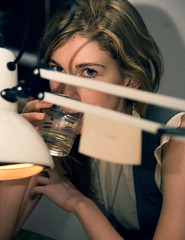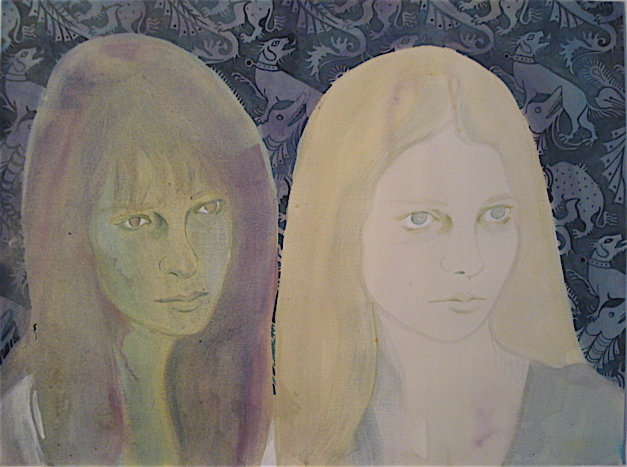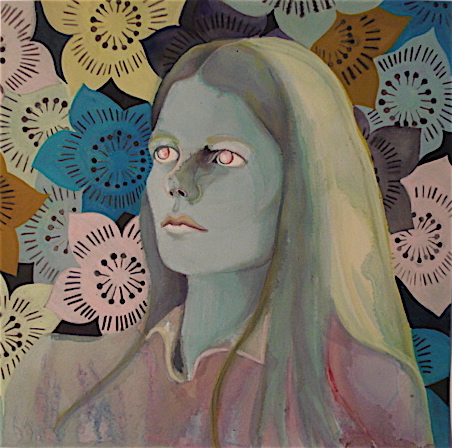 Caris Reid, twenty-six, lives and paints in a high-ceilinged space in Greenwich Village, not far from Bob Dylan’s first New York apartment. She mixes her paints in dozens of glass candle votives spread across the floor. She also writes regularly for the arts and culture journal Dossier. She professes shyness, though I have never seen it. Only brightness, warmth, and a certain amount of whimsy. She thinks of herself as an observer, yet to see her across a crowded room–strikingly tall, swan-like–one imagines she spends a fair amount of time as the observed as well. She currently has two paintings in a group show at the National Arts Club, curated by Michael Martin.
Caris Reid, twenty-six, lives and paints in a high-ceilinged space in Greenwich Village, not far from Bob Dylan’s first New York apartment. She mixes her paints in dozens of glass candle votives spread across the floor. She also writes regularly for the arts and culture journal Dossier. She professes shyness, though I have never seen it. Only brightness, warmth, and a certain amount of whimsy. She thinks of herself as an observer, yet to see her across a crowded room–strikingly tall, swan-like–one imagines she spends a fair amount of time as the observed as well. She currently has two paintings in a group show at the National Arts Club, curated by Michael Martin.
The Rumpus: You have two paintings in this show. “Catatonic” and “Under Said and Over Sung.” Tell me a little bit about them.
Caris Reid: They are imaginary portraits of these two girls, the Fox sisters, who I became fascinated with. They lived in upstate New York in the 19th century and when they were teenagers they started holding séances in their little town. They became famous as mediums and people came from all over the country to see the séances-out of revere, skepticism, and just pure entertainment. This whole spiritualist movement kind of grew out of it. But eventually the public grew suspicious of the sisters and they both ended up as these tragic alcoholics.

Rumpus: What drew you to them?
Reid: Well, I’m really curious about the supernatural. And you know, back then, women had very little power and here were these girls who had a tremendous amount of power who people believed were mediums, and could communicate with the dead. People turned to them for insight into their lives and what stocks to invest in. And they became celebrities at a time when so few women were in the spotlight. Which is amazing. But honestly, this whole story I’m telling you behind the painting, it’s not that important. I’m totally happy with people not knowing anything about the painting except what they see.
Rumpus: So what does it mean when you say they are “imaginary portraits”?
Reid: Oh, well, the way the actual Fox sisters looked didn’t interest me, and it wasn’t the way they looked in my head, but I knew I wanted to paint them. And I was watching this French film called The Escapees, and realized the two lead actresses looked exactly how I imagined the sisters to look. So I took stills form the film and cast the actresses as my Fox Sisters.
Rumpus: The girl in “Catatonic” is so beautiful, but her eyes are really haunting. She’s painted against a backdrop of giant flowers that are almost too perfect looking to be real flowers. Is it meant to be wallpaper?
Reid: I’m not sure where the flowers come from. Yeah, they look like a pattern, not like flowers in a field. It’s kind of like the interior of her mind. I like the idea that we’re gazing into her head and there’s nothing there really, just these flowers, keeping her in a kind of frozen trance like state.

Rumpus: Your paintings have an almost blurred look. Like slightly under developed photographs.
Reid: I work with inks and gouache, which are water-based, unpredictable and can be hard to control. I love that. The color palette is pretty much muted pastels, which I like because I’m fascinated by ambiguity. Things—thoughts, feelings, dreams—in transit. The spaces in-between. Pastels lend themselves well to my work because they are the colors of in-between. I want to create an ethereal, fluttering look.
Rumpus: I’m curious about where that comes from.
Reid: Oh, God…
Rumpus: Caris, when you interviewed me about my film Shrink, you psychoanalyzed me.
Reid: Ok, ok. (laughs) Well, my father works in the hotel business, so we moved around a lot when I was growing up. I was born in Washington, DC, and then lived in Boston, Chicago, and Austin. We moved to Dallas when I was fourteen. I went to eight or nine schools, lived in twelve different houses, and like, seven hotels. Moving around so much when you’re young, you develop a strange relationship with the past. It was like everything you knew to be solid before disappeared each time you moved. So I think I became fascinated by the disappearing act. And things in my work are always dissolving away, slipping through your fingers. And I dunno, I think very young, I became very suspicious of the outside world. It was always changing on me. So I started cultivating a strong inner life, and maybe my images are fluttering and fleeting, but I’m in control of them.
Rumpus: It’s hard for me to picture you in Texas. Has living in New York had an influence on your work?
Reid: It’s hard to say. I mean, I’m not terribly interested in painting the physical world, so in that sense, no. I’ve been very influenced by the people I’ve met in New York. They keep me motivated to work harder, and to share my ideas, not just keep it all in my head. As far as Texas goes, I never really fit in. I always had fantasies of running away. (laughs) I did run away from school once, when I was fourteen. My dad dropped me off one morning and I hid in the bushes as everyone was going in, then I walked away.
Rumpus: How far did you get?
Reid: I walked around for like an hour and a half. Then I walked home. My mom was in the driveway unloading groceries. She made me some tea then drove me back to school.
Rumpus: And years later you’re influenced by a film called The Escapees. Interesting.
Reid: Actually, I did a painting a coupe years ago called “Runaway.” It’s of a kid in the middle of the woods surrounded by toys. It was in a show.
Rumpus: Did it sell?
Reid: Yeah. (laughs) My parents bought it.
See more of Caris’ art on her website.




